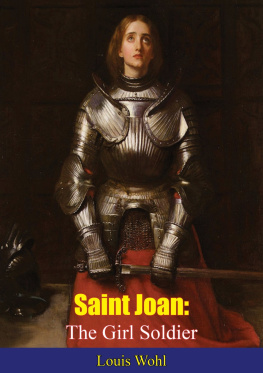JOAN OF ARC
JOAN OF ARC
By Herself and Her Witnesses
RGINE PERNOUD
Translated from the French by Edward Hyams

1994 edition with a new cover published by
SCARBOROUGH HOUSE
Lanham, MD 20706
A SCARBOROUGH BOOK REISSUE 1982
First Stein and Day Paperback edition 1969
First published in the United States of America by
STEIN AND DAY/ Publishers, 1966
This translation copyright Macdonald & Co (Publishers) Ltd., 1964
First published in the French language in 1962 as
Jeanne dArc par elle-mme et par ses tmoins
Copyright 1962 by Editions du Seuil
All rights reserved
Printed in the United States of America
Library of Congress Cataloging in Publication Data
Pernoud, Rgine, 1909
Joan of Arc by herself and her witnesses.
A Scarborough book.
Translation of: Jeanne dArc par elle-mme et par ses tmoins.
Includes index.
1. Joan, of Arc, Saint, 1412-1431. 2. Christian saintsFranceBiography. I. Title.
DC 103.P3783 1982 944.0260924 [B] 82-19312
ISBN 13: 978-0-812-81260-2
To the Reverend Daniel S. Rankin
TRANSLATORS NOTE
The usual practice in translation is to try to put the work in question into good English while retaining as much as possible of the style and feel of the original. This may entail some departure from the most literal translation of the foreign language. I have not felt entitled to do much in that way with the fifteenth-century documents which Mlle. Pernoud has here put together to compose an absorbing narrative. Some of her witnesses spoke or wrote smoothly enough; in others there is an awkwardness, often an expression of personality or feeling, which it was clearly my duty to retain. I offer this brief explanation in order that not all the oddities of, for example, sentence construction be attributed by indignant critics and readers to me.
E.H.
INTRODUCTION
Tuesday, the tenth day of May, it was reported and publicly said in Paris that on the Sunday last the Dauphins people in great number had, after several and sustained assaults in arms, entered into the fortress held by William Glasdale and other English captains and men-at-arms of the Kings, with the sortie tower of the Orleans bridge across the Loire, and that on this day the other captains and men-at-arms laying siege (to Orleans) and holding the forts across the river from Orleans had departed from the said forts and raised the siege to go to the comfort of the said Glasdale and his companions and to combat the enemies who had in their company a Maid alone bearing a banner in the midst of the said enemies, if it be as they say.
This account is entered in one of the registers of the Parliament of Paris, which even now comprise one of the most impressive collections to be found in the National Archives (more than twelve thousand parchment registers forming Series X.1A, the earliest of which go back to the thirteenth century). On the date when it was written, Tuesday, May 10, 1429, the clerk to the Parliament was Clement de Fauquembergue, an exact and conscientious scribe, who had acquired the habit of setting down the principal news of the day as well as the minutes of trials, pleas and other judicial business which it was his job to record; so much is this the case that the series of registers kept by him forms a sort of official journal for his time.
In the margin of his register, beside the above note, the clerk has drawn with his pen a little sketch; no more importance should be attributed to it than to the doodles with which we decorate the margins of our telephone books while waiting for a number; he had not seen Joan and knew no more about her than what he has told us; but this little drawing has nevertheless often had the honour of being reproduced in our time; and it is worthy of it, for it is the only effigy of the heroine, drawn during her lifetime, that we possess.
The account in question is, for all its brevity, rich in meaning. Those whom Clement de Fauquembergue refers to as the enemies are the French. And if he, albeit clerk to the Parliament of Paris, calls them so, it is because at the time Paris had been for ten years in the hands of the occupying power, England. A brief reminder of the principal dates will be in place here: 1415, Agincourtthe French army wiped out, with seven thousand killed as against five hundred English, and 1,500 prisoners, including an illustrious member of the French royal family, Charles, Duke of Orleans. 1418, the English enter Paris with the complicity of the Duke of Burgundy, John the Fearless; the King, Charles VI, is mad, and the Queen, the all too celebrated Isabeau of Bavaria, plotting with the enemy. Henry V of Lancaster, King of England, figures not only as victor but almost as God-sent, to chastise the French for the evil vices which reign in their midst. Speaking of the French when he visited Charles of Orleans imprisoned in the Tower of London, Henry was to say God wished to punish them. And indeed, and especially since 1392 when the Kings intermittent madness first became manifest and he handed the kingdom over to various members of his family, Frances rulers had shown only the worst possible kind of selfishness, taking advantage of the Kings condition to satisfy their personal ambitions and the rivalries of hatred which so soon arose among them.
The future of the dynasty was but ill-ensured by a family showing clear symptoms of degeneracy: three dauphins, Charles, Louis and Jean, had died in succession between 1401 and 1417. Of Isabeaus six sons, the dauphin referred to by Fauquembergue, the future Charles VII, born 1403, was to be the sole survivor. It was the period when, in a phrase current at the time, there is great pity in the Kingdom of France, given over to pillage, held to ransom by armed adventurers, ravaged by wars and by the epidemics which had followed one upon another for almost a centurysince the Black Death in 1348.
We come then to the Treaty of Troyes, May 21, 1420, which disinherited the Dauphin Charles in favour of Englands King, Henry V. On June 2nd following, Henry married a daughter of Charles VI and Isabeau, Catherine, whose sister Michelle was thereafter married to Philip the Good, Duke of Burgundy. Under their aegis there was established in France the so-called Double MonarchyFrance and England united under the English crown; henceforth the lilies of France were quartered with the leopards of England in the royal arms.
But only two years later, on August 31, 1422, Henry died suddenly in the pride of youth and victory. A few weeks later, on October 21, Charles VI, an old man at fifty-three, followed him into the grave. These deaths left the ten-month-old heir, Henry VI, who had been born to Henry V and Catherine, confronting the prince still known as the Dauphinsubsequently Charles VII. But their respective strengths were not equally balanced; under the regency of the infant Kings uncle, John, Duke of Bedford, Englands dominion was firmly established in the Ile-de-France and in Normandy. If the territory controlled by the English be joined to that of their ally, the Duke of Burgundy, then all the north and east of France was Bedfords, whereas Charles was derisively called The King of Bourges. Charles had dug himself in south of the Loire, in country still loyal to him; but elsewhere only a handful of places still held out against Anglo-Burgundian pressure: Mont St. Michel, which, in the midst of its waters, held the enemy at bay for forty years; the town of Tournai; the little city of Vaucouleurs; and, above all, Orleans, which commanded the principal bridge over the Loire.
Next page












